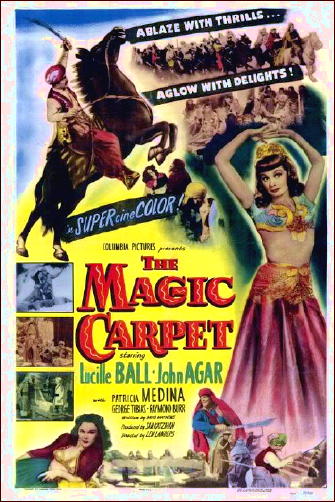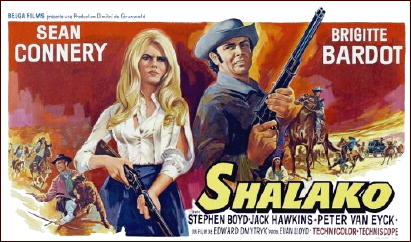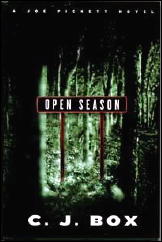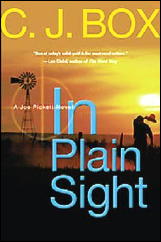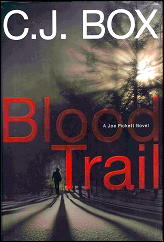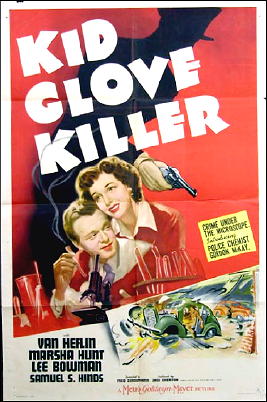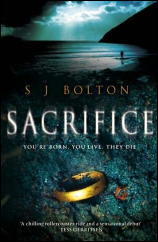August 2010
Monthly Archive
Sat 14 Aug 2010
Posted by Steve under
Reviews[8] Comments
A REVIEW BY CURT J. EVANS:
MIGNON G. EBERHART – The Glass Slipper. Doubleday Doran & Co., hardcover, 1938. Paperback reprints include: Century #35, 1945 (digest-sized); Popular Library 60-2182, 1965.
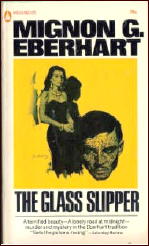
Poor Rue Hatterick. Sure, Rue was the night nurse for beautiful, rich Crystal Hatterick, wife of the brilliant Chicago surgeon Brule Hatterick. Sure, a few months after Crystal’s sudden death Rue married Brule.
Sure, someone is now writing letters to the police telling them Crystal was poisoned. Sure, Crystal’s former day nurse, who seems to know something about Crystal’s death, suddenly expires while having tea with Rue. Sure, Rue has a bag of potentially lethal medicine in her closet, left over from her nursing days.
Are those any reasons for the nasty police to suspect sweet and innocent Rue of MURDER?!!
With the publication of her ninth mystery novel, Fair Warning (1936), Mignon Eberhart hit upon a lucrative mystery recipe that was to last her for over fifty years, with only minor variations.
Take a young, pretty, nervous, motherless and fatherless girl, plunge her into a triangular love relationship with two men (one usually a husband or husband-to-be), and add a motherly older woman (an aunt or such like), a beautiful, more sophisticated, snotty-bitch female rival, an opulent yet rather shadowy and creepy mansion, a half-dozen or servants, some frightening policemen and a murder or two and you have a delightful, if a bit predictable, souffle a la Mignon.
By The Glass Slipper, Eberhart’s third mystery novel after Fair Warning, the taste indeed has become familiar, but the dish still goes down lightly and smoothly. It’s an enjoyable enough read, with a teasing bit of the bizarre that is something out of Ellery Queen or John Dickson Carr (the murder victims all have hands that have turned green).
But there’s really no way for the reader fairly to deduce the criminal (though s/he may guess it on GA mystery aesthetic principles), unlike with some of Eberhart’s earlier books. So only a B for this one.
Previously reviewed on this blog:
Woman on the Roof (by Steve Lewis)
Film: The Patient in Room 18 (by Steve Lewis)
Sat 14 Aug 2010
Reviewed by DAVID L. VINEYARD:
THE MAGIC CARPET. Columbia Pictures, 1951. Lucille Ball, John Agar, Patricia Medina, Raymond Burr, Gregory Gaye, George Tobias, Rick Vallin. Directed by Lew Landers.
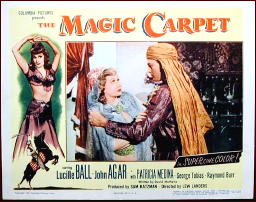
“You would be caliph, I a queen. Why not caliph and queen together?”
Lucille Ball had to be gnashing at the bit in this low budget Arabian Nights fare with John Agar’s flat Midwestern monotone marking him as the most unlikely Arabian swashbuckler since Oklahoma cowboy Dale Robertson and Paul Henreid.
Ball’s career had begun as a chorus girl at MGM (if you look quickly you can spot her wearing little but long blonde hair in an early Eddie Cantor outing Roman Scandals), with a long but steady climb up to stardom marked by mostly minor films with a few good roles in major fare like Stage Door (with Katherine Hepburn and Ginger Rogers), a brief period of popularity in films like Du Barry Was A Lady, The Big Street, and Easy To Wed (in the Jean Harlow role from Libeled Lady), and even credit for discovering one of MGM’s greatest stars — Van Johnson.
Even after leaving MGM for RKO she enjoyed some success, and just one year before this had scored well with Bob Hope in Fancy Pants, a technicolor remake of Ruggles of Redgap.
But in 1951 she was limited to doing films like Magic Carpet with leads like John Agar — a long fall from the likes of William Holden, Gene Kelly, and co-starring with Spencer Tracy and Katherine Hepburn (Without Love) and films like The Dark Corner, Lured, Miss Grant Takes Richmond, and Sorrowful Jones.
Luckily for her she had options. My Favorite Husband, her long running hit radio series with Richard Denning was being considered for television, and she and Cuban band leader husband Desi Arnaz had plans for that medium …
The Magic Carpet is Arabian Nights by rote. The Caliph is over thrown by evil Ali (Gabriel Gaye) and his henchman Boreg al Buzzar (Raymond Burr), who murder the Caliph and his wife, but not before she places their infant son on the magic carpet of the title, which carries him to safety and the sanctuary of a local physician, her uncle.
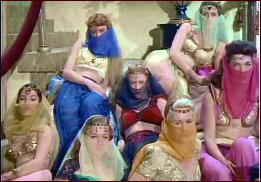
The true Caliph grows up to be Dr. Ramoth (John Agar), who is also the bandit leader, the Scarlet Falcon, bane of the Caliph Ali and his Grand Vizer Boreg and their corrupt reign.
In something of a twist, Lucille Ball is not the heroine of the film. That doubtful honor goes to Patricia Medina, who was virtually a staple in this sort of thing — and has here one of the worst dance numbers in the history of Arabian Nights nonsense. Lucy is Princess Narah, the evil Ali’s willful and sexually predatory sister, while Medina is Lida, the sister of Razi (George Tobias — and you have to wonder at the genetics that produced those progeny), the Scarlet Falcon’s right hand man.
Meanwhile Dr. Ramoth inveigles his way into the royal palace as court physician where he is a great hit with Narah and the Harem, and when his uncle is murdered by suspicious Boreg learns of his own royal birth and the magic carpet, excuse for some terrible special effects and mediocre mat paintings.
I’d like to say Lucy does her best as the semi evil Narah, but frankly both she and Medina play their respective roles like a pair of feuding strippers with Lucy’s attempts to seduce poor wooden Agar almost as funny as some of her routines on I Love Lucy, if not intentionally.
Substitute a G-string and pasties for their Arabian finery and move the plot backstage at a burlesque theater and you’d never notice the difference. If this film was any flatter, it wouldn’t even be in two dimensions.
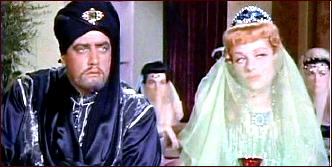
These things depend on the good will of the audience and the ability of the actors to make us want to believe in the silly but colorful goings on. In the hands of a Cornell Wilde, Jon Hall, or Jeff Chandler and a leading lady like Maria Montez, Maureen O’Hara, Rhonda Fleming, or even the unlikely Virginia Mayo the whole nonsensical thing can be great fun. Here no one seems even willing to try. It doesn’t even rise to the level of cynical exploitation.
Lucille Ball didn’t make another film until The Long Long Trailer in 1953, an attempt to cash in on the success of I Love Lucy. She did a few films in later years, notably with Bob Hope and Henry Fonda, and bowing out from film finally with the hideous film version of the Broadway musical Mame.
Her legendary television career and the success of Desilu studios more than made up for it, but you have to think she would have preferred to go out of her big screen career on a better note.
I’m usually forgiving of these, and even will admit to a taste for the better ones, but this has worse production values than an episode of I Dream of Jeanie, and performances that would have to be upgraded to reach the level of a burlesque comedy routine.
Still, Raymond Burr at his heaviest and wielding a scimitar is a sight you don’t often see (“This time Doctor, you must tend to a man and not on the ladies of the Harem!”), and the fact that Lucy was pregnant might somewhat mitigate her flat performance — this script would have been enough to give anyone morning sickness:
Narah: You would not put a princess in the dungeon?
Ramoth: I wouldn’t if she were a princess.
Ramoth regains his throne, Lucy and the evil Ali get their comeuppance, and Ramoth and Lida get a final clench on the magic carpet:
Lida: How long I’ve waited for this.
Ramoth: It’s not easy to embrace a tigress.
Lida: From now on you see a lamb.
Ah, well, it could be worse. Though I’m not exactly sure how.
Editorial Comment: The whole movie appears to be available on YouTube. This link will take you to some excerpts, so that you may get an overall impression of the film, should you care to continue.
Fri 13 Aug 2010
SHALAKO. Cinerama Releasing Corporation, 1968. Sean Connery, Brigitte Bardot, Stephen Boyd, Jack Hawkins, Peter Van Eyck, Honor Blackman, Woody Strode, Alexander Knox, Valerie French, Donald Barry. Based on the novel by Louis L’Amour. Director: Edward Dmytryk.
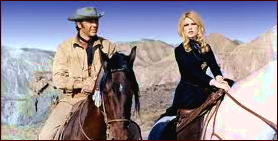
An all-star cast. Make that an international all-star cast. To little or no avail, alas. Not that any western isn’t worth watching, if filmed in color and with a large enough budget, as this one very definitely is, and even on occasions when not.
The movie takes place in the 1880s, supposedly in New Mexico but actually in studio lots in England and on location in Spain. (The vegetation is therefore generally wrong, but the mountain and rough terrain vistas are very fine.)
The basic premise of the film is simple. An aristocratic hunting expedition from Europe, complete with fine silver, champagne (unchilled), butlers and other assorted servants, wanders into Apache land, and it’s up to an Army scout names Shalako (Sean Connery) to warn them off, and when that fails, to get them to safety before they all die.
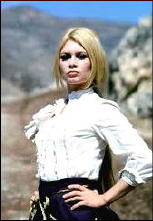
The warning fails, naturally enough. The blame here goes to the nominal leader of the group, Baron Hallstatt (Peter Van Eyck), who has enough arrogance and stubbornness to hold off any number of Indians, if that were all it took, and it isn’t.
I imagine this movie, when they were putting together the cast, was designed primarily for the pairing of Sean Connery and Brigitte Bardot (Countess Irina Lazaar) as the two leading characters, but they seldom have much screen time together and when they are together, it’s not particularly a match made in heaven.
I think more sparks would have been kindled if Honor Blackman (who plays Lady Julia Daggett) had played Miss Bardot’s part instead, but she does all right in her role as a woman frustrated by her dry stick of a husband (Jack Hawkins) and who rides off with the the villainous Bosky Fulton (Stephen Boyd) instead. A bad choice, as it turns out, but she didn’t listen to me, either.
We do get to see Miss Bardot in a skinny dipping scene, but all in all, it’s a totally gratuitous one, since even though Shalako gets an admiring view, the plot doesn’t seem to depend very much upon it.
Fri 13 Aug 2010
Posted by Steve under
Reviews[3] Comments
REVIEWED BY DAN STUMPF:
JONATHAN GANT – Never Say No to a Killer. Ace Double D-157, paperback original, 1956.
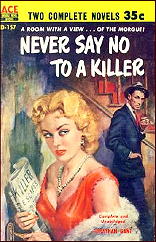
Someone on this blog recommended Never Say No to a Killer by Jonathan Gant, so when I found a copy cheap, I picked it up. And I’m glad I did.
This one owes a lot to Horace McCoy’s Kiss Tomorrow Goodbye, starting with a prison break, and hurtling the violent, amoral protagonist into near-control of illicit activities in a big city until he’s tripped up by…
Well, that would be telling too much, and while Never Say No speeds across the same ground as Kiss Tomorrow, it lacks the depth and vocabulary of Horace McCoy’s classic.
What it does offer is fast, slick writing and a pace that never falters. Worth checking out for fans of hard-boiled crime willing to waste a few hours enjoyably.
Editorial Comments: The “someone” who brought this book up earlier was Bill Crider, in of his columns on Gold Medal writers which he originally did for the print version of Mystery*File. The writer he discussed, though, was Clifton Adams, Jonathan Gant being a pen name he sometimes used. You can read the entire piece here on the blog.
The other half of this particular Ace Double paperback was Stab in the Dark, by Louis Trimble. Nothing by Trimble under his own name has been reviewed here on the blog, but I did one of Bring Back Her Body, which he wrote as by Stuart Brock. You can find it way back here.
Fri 13 Aug 2010
IT IS PURELY MY OPINION
Reviews by L. J. Roberts
C. J. BOX – Nowhere to Run. Putnam, hardcover, April 2010. Paperback reprint: Berkley, April 2011.
Genre: Licensed investigator. Leading character: Joe Pickett; 10th in series. Setting: Wyoming.
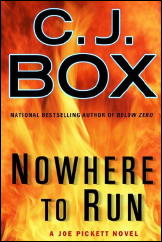
First Sentence: Three hours after he’d broken camp, repacked, and pushed his horses higher into the mountain range, Wyoming game warden Joe Pickett paused on the lip of a wide hollow basin and dug in his saddlebag for his notebook.
Game Warden Joe Pickett is making the last pass before going home through the territory he has been covering for the past year. He’s following up on reports of vandalism and other hunter’s game butchered out. He doesn’t expect to run into twin brothers who resent being asked to follow the rules and nearly cost Joe his life.
He also doesn’t expect the only reason he escapes is a woman who may have been an Olympic contender but disappeared. His determination to enforce the law and to possibly rescue the woman sends Joe, with his friend Nate, back into the mountains and an old-West showdown.
Box writes books that are entertaining, exciting and occasionally touching. He also writes book that make you think about the bigger issues and does it in such a way that doesn’t preach or become didactic, but makes you weigh both sides of the question and make your own choice. That is a real talent.
The character of Joe Pickett is one of an average man; very human, married, loves his family, loyal to his friends. He learns he is not invincible, but believes in his job even it’s dangerous and, perhaps, not smart… “It’s my job. I do my job.”
Even his wife, Marybeth, acknowledges his job is who he is… “You do what you do because you’re hardwired for it. You get yourself into situations because you have a certain set of standards…”
That relationship and those principles give Joe the structure that defines him. The interaction between Joe and the other characters is believable, and occasionally humorous.
In this book, Box has given Joe two very challenging enemies; both in terms of surviving against them, but opposition of views on issues that are very timely. One thing, of which I am becoming very tired, is the overuse by authors of the ignorant, obstructive, jealous superior official. Yes, I know it all-too-often exists, but it has become rather cliché.
The pacing is wonderful; it fluctuates between tension and rest. Box’s descriptions demonstrate his knowledge and love of Wyoming, and shares that with us by taking us along and letting us see what Joe sees, both in terms of its beauty and potential danger.
The dialogue has a natural flow and refreshingly little profanity. This is a very good story. I became so involved, it was a one-sitting read for me and I am now anxious for the next book.
Rating: Very Good.
The Joe Pickett series —
1. Open Season (2001)
2. Savage Run (2002)
3. Winterkill (2003)
4. Trophy Hunt (2004)
5. Out of Range (2005)
6. In Plain Sight (2006)
7. Free Fire (2007)
8. Blood Trail (2008)
9. Below Zero (2009)
10. Nowhere to Run (2010)
Mon 9 Aug 2010
Since late last week we’ve been packing up Jon’s apartment for his forthcoming move to the DC area (Bethesda, MD, to be exact). He’s the recent law school graduate, as you may recall.
It’s taken up way too much time already, it’s been hot, and I’m going to stop fooling myself that I can come home and start blogging until it’s done. The movers are coming Wednesday and he leaves on Thursday. By Friday things may be back to normal.
But don’t expect to see anything new here until then, except maybe comments from me on recent posts. Sorry about that, but I’ll be back when I can!
— Steve
Sat 7 Aug 2010
REVIEWED BY WALTER ALBERT:
KID GLOVE KILLER. MGM, 1942. Van Heflin, Marsha Hunt, Lee Bowman, Cliff Clark, Eddie Quillan, John Litel, Cathy Lewis. Director: Fred Zinneman. Shown at Cinecon 27, Hollywood CA, September 1993.
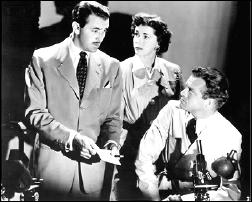
Marsha Hunt, who co-starred with Van Heflin and Lee Bowman in this crackerjack MGM programmer, was sitting a couple of rows in front of me for the screening. She looked about forty when she turned around to acknowledge the audience applause and she gave the best interview I heard at the convention, answering questions precisely, fully and intelligently.
In Kid Glove Killer she played the assistant of a crime-lab doctor (Van Heflin), with her attentive suitor and eventual chief suspect in a bombing-murder played by Lee Bowman, perennial lose-the-girl second lead in romantic comedies.
This was Fred Zinneman’s first directorial stint and Hunt described how he won over the entire crew on the first day of the shooting with a short speech in which he welcomed suggestions from his experienced cast and crew.
Zinneman, of course, went on to a distinguished career, as did Van Heflin, while Hunt, when her movie career faded in the early fifties, moved on to TV and Broadway. She was at Cinecon to sign copies of her new book, Marsha Hunt’s Hollywood. She seemed genuinely touched by the audience’s appreciation and a nice person into the bargain.
Luckily, the film was another sleeper that everybody seemed to enjoy. All that wonderful MGM polish lavished on a B-movie script. Quite a tribute to the old studio system.
Sat 7 Aug 2010
IT IS PURELY MY OPINION
Reviews by L. J. Roberts
S. J. BOLTON – Blood Harvest. Bantam Press, UK, hardcover/softcover, 2010. US edition: St. Martin’s Press, hardcover, 2010.
Genre: Suspense. Leading characters: Rev. Harry Laycock / Dr. Evi Oliver / ensemble; standalone (3rd book). Setting: England.
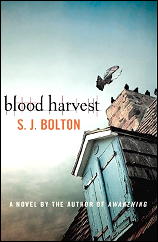
First Sentence: “She’s been watching us for a while now.”
Reverend Harry Laycock has come to his new parish which includes Heptoncough in the Yorkshire Pennines. Here there is an old church, a very old church a village which still carries out the old traditions and where young girls have disappeared or died.
One of the girls died in a house fire, but her mother, Gillian, never accepted her death and constantly roams the moors at night. Psychiatrist Evi Oliver is trying to help her put her life back together.
Tom Fletcher and family have moved to the village having bought the only new house built in many years. It was built on the old Church’s land, next to the graveyard. They all learn that events of the past are still part of the present.
Although I really liked Ms. Bolton’s first two books, this one knocked my socks off. Everything about it was so well done, it’s hard to know where to start.
Even from the page before the prologue, I was captivated. I am not a particular fan of prologues, but this one really worked. I was introduced to a number of the significant characters who immediately jumped off the page and made me want to know more about them.
I am also not usually a fan of ensemble casts. Again, this worked. Although Harry, the antithesis of a stuffy vicar and for whom I would have provided a different surname, and Evi, the physically impaired, intelligent and independent psychiatrist, are the pivotal characters, all characters were alive and their interactions realistic.
Dialogue is such an important element of a story. Ms. Bolton has a skill with dialogue that echoes in cadence the speech of the characters. As well as establishing a strong sense of place, she incorporates the history and traditions of the area.
Combined with all these ingredients, what caused me to read this 421 page book in eight straight hours was the author’s voice and the plot. The first half of the book is an amazingly skillful balance of humor… “I haven’t had this much success with a woman since I got drunk at my cousin’s wedding and threw up over the maid of honour.” … and underlying, delightfully creepy menace.
There is a real sense of “things that go bump in the night” which made me happy I was reading the book during the day.
The second half of the book moved to police and forensic investigation, and a race-against-time fear, while the climax was filled with an increasingly ratcheted tension and surprises right up to the very end.
One observation is that Ms. Bolton does have a penchant for her female protagonists to be somehow physically impaired. While the overcoming of the particular impairment shows the character’s strength and resolve, it can also become formulaic or even cliché over time.
However, as this is a general observation and not a criticism of this particular book, it does not impact my rating at all. In this case, it greatly added to the suspense. This really was an exceptional, “wow” book and one I shan’t soon forget. I cannot wait for Ms. Bolton’s next book
Rating: Excellent.
Novels by S(HARON) J. BOLTON —
1. Sacrifice (2008)
2. Awakening (2009)
3. Blood Harvest (2010)
Sat 7 Aug 2010
A TV Review by MIKE TOONEY:
“Last Seen Wearing Blue Jeans.” An episode of The Alfred Hitchcock Hour (Season 1, Episode 28). First air date: 19 April 1963. Michael Wilding, Anna Lee, Katherine Crawford, Randy Boone, James Anderson, Jesse Jacobs, Eve McVeagh, Russ Conway. Teleplay: Lou Rambeau, based on the novel Encounter with Evil, by Amber Dean (1961). Director: Alan Crosland, Jr.
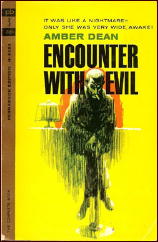
David and Roberta Saunders (Michael Wilding, Anna Lee) are touring America by station wagon with their teenage daughter Loren (Katherine Crawford). They make a late-night stop at a small diner on the Arizona-Mexican border to eat; after the meal a very sleepy Loren returns to the wagon and continues slumbering in the back.
Some time later she wakes up, just in time to witness a murder. To her horror, she quickly realizes that she has crawled into the wrong car and been driven across the border without the killers being aware of her — but now they are. All she has to do is stay alive …..
There’s something appealing about having Sleeping Beauty exposing an international criminal conspiracy — even if it’s unintentionally — and seeing Prince Charming drive a jeep. But as for this beauty’s detectival skills, Nancy Drew she ain’t.
Michael Wilding’s criminous credits include Stage Fright (1950, with Hitchcock); Trent’s Last Case (1952, as one of the very few actors ever to play Philip Trent in films and TV); The Naked Edge (1961); and one appearance each on Burke’s Law (1963), The Girl from U.N.C.L.E. (1966), and Mannix (1968).
Anna Lee appeared in The Four Just Men (1939), Hangmen Also Die! (1943), Bedlam (1946), Prison Warden (1949), Whatever Happened to Baby Jane? (1962), In Like Flint (1967), and the long-running soap opera General Hospital. According to IMDb, she was also the goddaughter of Arthur Conan Doyle.
Randy Boone was a regular on the TV westerns The Virginian (1963-66) and Cimarron Strip (1967-68), the latter featuring an episode, “Knife in the Darkness,” written by Harlan Ellison in which Jack the Ripper is loose in Cimarron.
“Last Seen Wearing Blue Jeans” is available on Hulu here.
Editorial Comment: Anna Lee also appeared in King Solomon’s Mines, the 1937 version, reviewed here by me not so very long ago.
[UPDATE] 08-09-10. I neglected to mention (which is a euphemism for saying I forgot) that a review I wrote of Snipe Hunt, another one of Amber Dean’s mystery novels, was posted on this blog way back here, along with a complete listing of her “Abbie Harris” series.
Fri 6 Aug 2010
LADY CHASER. Producers Releasing Corporation, 1946. Robert Lowery, Ann Savage, Inez Cooper, Frank Ferguson. Based on the story “Lady Killer,†by G. T. Fleming-Roberts (Detective Tales, July 1945). Director: Sam Newfield.
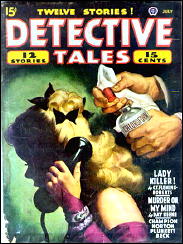
It’s surprising, when you stop to think about it, that more movies weren’t based on stories that appeared in the pulp magazines, or at least those of the B-movie variety, either mysteries or westerns and even love stories.
Both genres are based on quick action and minimal characterization, they’d be a natural for each other, and probably there are more adaptations than I’m thinking of, speaking off the top of head as I usually do when I sit down to write a review.
A quick synopsis of Lady Chaser ought to be what I really begin with, seeing that there isn’t one on IMDB, nor any comments either, at the present time. The movie begins with two women writing letters across from each other in a room designed for that purpose in a downtown department store. One’s a blackmailer (Ann Savage), the other (Inez Cooper) is writing a letter to her fiancé (Robert Lowery).
The latter has an uncle who’s opposed to the marriage, the former is, unfortunately, in over her head. The latter has a headache; the former gives her an aspirin. The latter gives the aspirin, unused, to her uncle, who dies. The aspirin was poisoned.
You can figure out what happened, can’t you? And so can the fiancé, eventually, only he can’t prove anything, nor can he can convince the dunderheaded head of homicide (Ralph Dunn) that there’s anything to her story, and with the lack of a better one, she’s quickly convicted of the crime. Amateur detective work is always better than that of the police, in stories like this.
There are a surprising number of twists that occur in Lady Chaser, especially when you consider that it’s only 58 minutes long. The problem is that to get to the twists there are some awfully creaky plot devices that have to be swallowed whole, or if not, there’s no other alternative but to throw up your hands and say Enough.
I’d also have tried to conceal the killer’s identity a little while longer, but neither can I think of a way to avoid it, so we’ll have to call that a draw. My recommendation, if this movie should ever come your way, is to simply sit back and enjoy it, warts and all.
NOTES: Previously reviewed on this blog was The Limping Man, by Frank Rawlings, a pen name of G. T. Fleming-Roberts.
For a complete bibliography of Fleming-Roberts, including several articles and reviews, check out this page on the primary Mystery*File website.
« Previous Page — Next Page »




